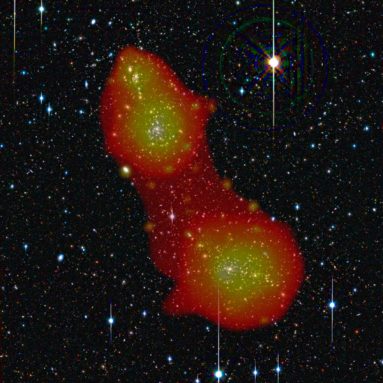An invisible cosmic bridge
Astronomers find strange stuff in the space between two clusters of galaxies

ESA/ XMM-Newton/ EPIC/ ESO (J. Dietrich)/ SRON (N. Werner)/ MPE (A. Finoguenov)
Abell 222 is a giant group of galaxies in deep space. So is Abell 223 — one of Abell 222’s nearest neighbors. Each galaxy in each group is home to a massive number of stars, which means the clusters are brimming with light. But if you peer through a telescope at the space between the two galaxy clusters, you won’t see anything, just a dark patch of sky. The scenery would be the same if you could ride a spaceship from one group of galaxies to the other.
The space between the two galaxy clusters is, however, anything but empty, according to a new study by astronomers. An invisible bridge made from mysterious stuff called dark matter connects the two clusters. Dark matter is hard to study because it doesn’t glow or put out any radiation — which means we can’t see it or measure it directly. Astronomers know it’s there, though, because of its effect on objects we can see.
Scientists suspect that giant webs of dark matter lurk in outer space. Galaxy clusters form in the thick spots where the web’s threads come together. Most of the matter in the universe is probably contained in these invisible threads, also called filaments. The dark matter bridge that stretches from Abell 222 to Abell 223 is believed to be one of these filaments.
“Filaments of dark matter have never been seen,” Jörg Dietrich told Science News. But “for the first time, we successfully mapped one,” says this astronomer at the University Observatory Munich in Germany.
Dietrich and his colleagues suspected they’d find a filament between the two clusters because earlier observations showed a ribbon of hot gas there. That gas hinted that something else was present.
The scientists couldn’t actually see the filament. Instead, they studied the starlight that passed through it. Dark matter has mass, which means it has gravity. And since dark matter has a lot of mass, its gravity is superstrong: That causes light to bend as it moves through.
This is called “lensing.” You see lensing for yourself when you look through a drinking glass and notice how differently the room appears. You can also see it when you look through someone else’s eyeglasses. But in space, there’s no glass — gravity does the work instead.
By studying changes in the light, the scientists estimated that the filament has about as much mass as a galaxy cluster much smaller than either of the Abells. For comparison, imagine that scientists on Earth discovered an invisible bridge as heavy as a mountain connecting the peaks of two larger mountains.
Scientists don’t know what makes up dark matter. However, they hope that by understanding these invisible filaments, they may understand how visible galaxies and galaxy clusters formed in the first place.
Power words
dark matter Physical objects or particles that emit no detectable radiation of their own. They are believed to exist because of unexplained gravitational forces that they appear to exert on other, visible astronomical objects.
lens A transparent part of the eye behind the colored iris that focuses incoming light onto the light-absorbing membrane at the back of the eyeball. Or a transparent material that can either focus or spread out parallel rays of light as they pass through it.
gravity The force that attracts any body with mass, or bulk, toward any other body with mass. The more mass there is, the more gravity there is.
galaxy A system of millions or billions of stars, together with gas and dust, held together by gravitational attraction.
galaxy cluster A large group of galaxies held together by gravity.







